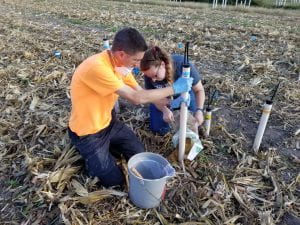Shober Lab Research
Current Research
Enhancing site assessments of agricultural subsurface phosphorus loss using geophysical surveys and conservative tracers (PI)
 Funding agency: USDA Agricultural Food and Research Initiative (AFRI) Foundational Program (Award # 2019-68016-29405)
Funding agency: USDA Agricultural Food and Research Initiative (AFRI) Foundational Program (Award # 2019-68016-29405)
Project cooperators: Anthony Buda, Casey Kennedy (USDA-ARS); Lee Slater, Dimitrios Ntalgliannis (Rutgers Univ. – Newark); Amy Collick (Moorehead State Univ.)
Students: Lauren Mosesso, PhD
This integrated research and extension project addresses stakeholder concerns about subsurface phosphorus (P) assessment. We seek to evaluate large-scale geophysics as an innovative tool for predicting subsoil properties that give rise to critical source areas of subsurface P loss. The near-term goal of the proposed research is to advance the precision of subsurface P management with P site assessment tools through the use of plot- and large-scale geophysical surveys that offer greater insight into the subsurface transport potential of artificially-drained agricultural fields. Our long-term goal is to foster a stakeholder driven process that will enable large-geophysical surveys to not only improve P use efficiency, but also enhance water quality and increase yields on the Delmarva Peninsula and similar agroecosystems with artificial drainage. The research will take place in selected agricultural fields on the Delmarva Peninsula, which is a region that best represents the challenges of controlling P losses in area where subsurface flows drive P transfers to surface waters. We will: 1) carry out large-scale geophysical surveys of ten or more representative fields to map the structural properties of topsoils and deeper soil layers affecting subsurface transport and hydrologic connectivity; 2) select three to five fields and conduct plot-scale sprinkling experiments with coupled electrical/hydrological tracer monitoring strategies to evaluate and verify critical source areas of subsurface transport mapped using large-scale geophysical surveys; and 3) conduct extension programs to demonstrate the value of using large-scale geophysical surveys to drive site-specific agronomic management and conservation.
A Solutions-based Evaluation of Barriers to Farmer Adoption of In-season Nitrogen Decision Support Tools (Co-PI)
Funding agency: USDA Natural Resources Conservation Service On-Farm Research Program
Project cooperators: Nicole Fiorellino (Univ. Maryland – College Park; PI); Jarrod Miller, Leah Palm-Forster, Kelly Davidson (Univ. Delaware); Charlie White (Penn State Univ.)
Students: Jeremy Newswanger, MS
Innovative Manure Management Strategies to Promote Phosphorus Balance and Sustain Agriculture on the Delmarva Peninsula (Co-PI)
Funding agency: USDA Agricultural Food and Research Initiative (AFRI) Foundational Program (Award # 2018-68008-28089)
Project cooperators: Mark Reiter (Virginia Tech; PI); Leah Palm-Forster (Univ. Delaware); Gurpal Toor (Univ. Maryland – College Park)
This project integrates research, extension, and educational activities to address the stakeholder identified critical issue of phosphorus (P) imbalance on the Delmarva Peninsula. We will: (1) investigate current soil fertility practices in P deficient and P surplus areas to identify practices Delmarva farmers are willing to adopt to maximize crop yields; (2) estimate and map (a) the current quantity of exported litter and (b) the current and potential use (demand) of poultry litter on the Delmarva Peninsula; (3) quantify the economic and yield benefits of using poultry litter on low P fertility soils; (4) develop a regional clearinghouse to connect farmers with a P deficit to farmers with P surplus on the Delmarva Peninsula, and (5) update and deliver poultry litter management and soil fertility recommendations for regional grain production to increase crop yields in P deficit areas. The goal is to better distribute poultry litter within the region by decreasing application of poultry litter in areas of P surplus (e.g., lower Eastern Shore) and increasing application in areas of P deficit (e.g., Upper Shore and Virginia's Eastern Shore). Better distribution of poultry litter on low P soils will improve grain yields, achieve P balance in the region, and reduce concerns about water quality impairment due to excessive P loss from P saturated soils. This project is submitted under the Critical Agricultural Research and Extension (CARE) program area (A1701) and addresses three Farm Bill priorities: Bioenergy, natural resources, and environment; Agriculture systems and technology; and Agriculture economics and rural communities.
Completed Research
Combining Electrical Resistivity Imaging and Conservative Tracers to Characterize Subsurface Phosphorus Losses from Drained Soils
Funding agency: Delmarva Land Grant Universities Seed Grant Program; USDA Agricultural Food and Research Initiative (AFRI) Foundational Program (Award # 2016-67019-25277)
Project cooperators: Anthony Buda, Ray Bryant (USDA-ARS); Lee Slater, Judith Robinson, Dimitrios Ntalgliannis (Rutgers – Newark); Arthur Allen, Amy Collick (Univ. Maryland Eastern Shore)
Students: Katie Turner (Clark), MS 2016; Lauren Mosesso, PhD Expected 2022
Integrated Nutrient Management for High Yielding Corn in a Poultry-Grain Production System
Funding agency: Delaware Department of Natural Resources and Environmental Control
Project cooperators: Joshua McGrath (UKY), J. Thomas Sims (UD, retired), Hong Li (UD)
Developing Best Management Practices to Reduce Nonpoint Source Pollution through Effective Ditch Management
Funding agency: Delaware Department of Natural Resources and Environmental Control
Project cooperators: Jennifer Volk (UD), J. Thomas Sims (UD, retired)
Students: Melissa Hubert (Savin), MS 2018
Final Report
Evaluation of Seeding Rate and Method on Establishment of Cover Crops in Delaware.
Funding Agency: USDA Natural Resources Conservation Service.
Project cooperators:
Quantifying the effects of irrigation and fertigation on nutrient use efficiency in corn.
Funding agency: Delaware Department of Natural Resources and Environmental Control
Project cooperators: James Adkins, Shawn Tingle, Jennifer Volk, Cory Whaley (UD)
Refining and harmonizing phosphorus indices in the Chesapeake Bay region to improve critical source area identification and to address nutrient management priorities.
Funding agency: USDA Natural Resources Conservation Service Conservation Innovation Grant Program
Targeted Conservation Contracts to Enhance Agricultural Best Management Practices: Incorporating Heterogeneity and Predicting Additionality
Funding agency: USDA Agricultural Food and Research Initiative (AFRI) Foundational Program.
Trends in Soil Test Phosphorous and Sorption Capacity following Long-term Application of Poultry Litter and Commercial Fertilizers.
Funding agency: Maryland Grain Producers Utilization Board
Using Silicon Fertilizers to Improve Soil Phosphorus Availability and Uptake by Winter Wheat in High Phosphorus Soils.
Funding agency: Northeast SARE Graduate Student Grant (awarded to Z. Qin)





